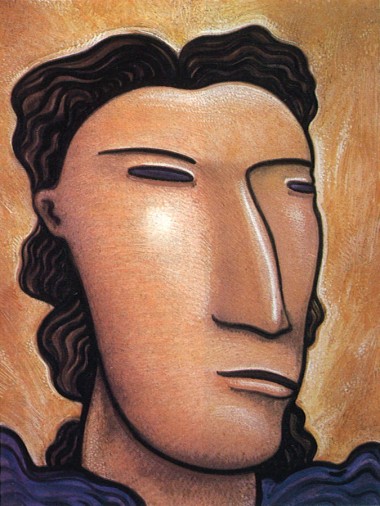by Marcia E. Vetrocq
Art In America, March 1985

Robert Gordy. Female Head, 1984. Monotype, 30 x 40 inches.
In the summer of 1982 painter Robert Gordy abandoned his arch, patternizing, Art Deco-inflected signature style. Since that time he has devoted most of his energies to making monotypes, and the principal focus of his attention has been the human head. Gordy’s second gallery showing of his new work was a knockout, some two dozen suave yet honest works without a ringer in the lot. The monotype medium has provided Gordy with a form of no-risk, gestural spontaneity, and a genuine “painterliness” emerges in the trailed lines and heavily worked or mottled areas, even as the luminous etching ink and insistent gleam of white paper preserve the essential flatness which has always been fundamental to Gordy’s art.
Regardless of size – and some of the new prints reach 40 by 30 inches or more – Gordy’s format consistently presents a closely framed and firmly outlined head, occasionally cropped at the forehead, usually furnished with a neck and slice of shoulder. Colors range from the canonical Cubist gray, ocher, green and brown to a splashier, Crayola-bright palette. The more graphically conceived prints hug the surface and wonderfully capture the sense of the hand at work. The more sculpturally modeled heads tighten the effect with stippled grounds and segments of radiant arcs recalling portraits by Juan Gris. It is in some of these latter, geometricized works, with their pull toward stylization and recurring emphasis on cheekbones, that Gordy’s earlier mannerisms linger, infiltrating the freshness of the new work.
Given the look and the timing of Gordy’s stylistic revision, one could be tempted to characterize the development as a Neo-Expressionist breakout. Yet Gordy’s monotypes, in origin and effect, stand far from any Expressionist prototypes. Neither anger nor imperiousness can be detected in Gordy’s manipulations of the human face, and it is control – not willfulness, inner necessity, or naiveté regained – that one reads in every stroke. The facial deformations and dislocations never translate as the artist’s alienation from the Other, nor is the viewer shocked, entreatied or bullied into empathetically experiencing Gordy’s relationship to a humanity via the image. Nor, in the contemporary context, are they primitivizing or fetishistic. Gordy rarely flirts with social caricature either, with the exception of Mahler-Lover, whose heaven-cast eyes, sensitively tapering nose, and sleek marcel create the mock epitome of the most exquisitely quivering estheticism.
Ultimately it is Matisse who emerges as Gordy’s ancestor in these works – the Matisse of Green Stripe (Madame Matisse). For above all else, we acknowledge Gordy’s equanimity in crafting a reconciliation among lived observation, free imagination, artistic convention, and the possibilities of a peculiar and recalcitrant medium. The most wrenchingly altered features – gaping mouths, dime-sized eyes, protuberant foreheads – derive their power from Gordy’s having taken liberties with the schema of representation, and not from a saving of the human face as directly seen. This is art born in the studio not the street, and it affirms that accepted artistic codes and not ordinary experience prepare us to attribute anxiety, suspicion or desolation to the rendered face whose graphic lineaments have gone awry. Gordy’s monotypes are smart, sophisticated images about making and perceiving, not feeling and expressing. What they may lack in heat, they more than generously make up for in intelligent light.
